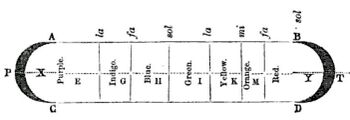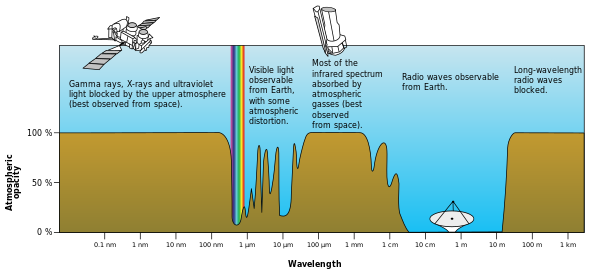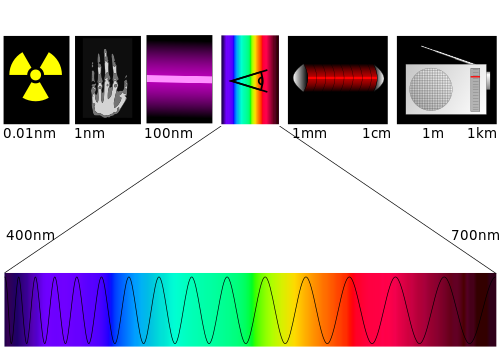الطيف المرئي

الطيف المرئي عبارة عن موجات كهرومغناطيسية متمثلة في موجات الضوء التي تتكون من ألوان الطيف السبعة: الأحمر والبرتقالي والأصفر والأخضر النيلي والأزرق والبنفسجي . لكل من هذه الموجات طول موجي معين يختلف عن الآخر وسرعة هذه الموجات هي نفس سرعة الموجات الكهرومغناطيسية و تساوي 300000 كم/ثانية وتنتشر هذه الموجات في خطوط مستقيمة ويمكن أن تسير في الفراغ وفي أي وسط شفاف أو شبه شفاف.
التاريخ


رؤية الألوان عبر الفصائل
Many species can see light within frequencies outside the human "visible spectrum". Bees and many other insects can detect ultraviolet light, which helps them find nectar in flowers. Plant species that depend on insect pollination may owe reproductive success to their appearance in ultraviolet light rather than how colorful they appear to humans. Birds, too, can see into the ultraviolet (300–400 nm), and some have sex-dependent markings on their plumage that are visible only in the ultraviolet range.[1][2] Many animals that can see into the ultraviolet range cannot see red light or any other reddish wavelengths. Bees' visible spectrum ends at about 590 nm, just before the orange wavelengths start.[3] Birds can see some red wavelengths, although not as far into the light spectrum as humans.[4] The popular belief that the common goldfish is the only animal that can see both infrared and ultraviolet light[5] is incorrect, because goldfish cannot see infrared light.[6]
Most mammals are dichromatic, and dogs and horses are often thought to be color blind. They have been shown to be sensitive to colors, though not as many as humans.[7] Some snakes can "see"[8] radiant heat at wavelengths between 5 and 30 μm to a degree of accuracy such that a blind rattlesnake can target vulnerable body parts of the prey at which it strikes,[9] and other snakes with the organ may detect warm bodies from a meter away.[10] It may also be used in thermoregulation and predator detection.[11][12] (See Infrared sensing in snakes)
ألوان الطيف
| اللون | طول الموجة | التردد | طاقة الفوتون |
|---|---|---|---|
| Violet | 380–450 nm | 670–790 THz | 2.75–3.26 eV |
| Blue | 450–485 nm | 620–670 THz | 2.56–2.75 eV |
| Cyan | 485–500 nm | 600–620 THz | 2.48–2.56 eV |
| Green | 500–565 nm | 530–600 THz | 2.19–2.48 eV |
| Yellow | 565–590 nm | 510–530 THz | 2.10–2.19 eV |
| Orange | 590–625 nm | 480–510 THz | 1.98–2.10 eV |
| Red | 625–700 nm | 400–480 THz | 1.65–1.98 eV |
Colors that can be produced by visible light of a narrow band of wavelengths (monochromatic light) are called pure spectral colors. The various color ranges indicated in the illustration are an approximation: The spectrum is continuous, with no clear boundaries between one color and the next.[13]
- الطيف المرئي هو جزء صغير متوسط من طيف الموجات الكهرومغناطيسية، وكل هذه الموجات تنتشر بسرعة الضوء ولا يمكن لأي مادة الانتشار بسرعة الضوء. وتسمية الطيف المرئي ترجع إلى أن العين البشرية ليست حساسة لجميع موجات الطيف الكهرومغناطيسي ، فهي تستطيع رؤية الطيف الكهرومغناطيسي الواقع بين موجة طولها 380 نانومتر ونحو 700 نانومتر (النانومتر = 1 على بليون من المتر)، تحدها الموجات تحت الحمراء الغير مرئية وأطوال موجاتها فوق 700 نانومتر ، وموجات الراديو وأطوال موجاتها بين السنتيمتر إلى عدة كيلومترات. وتحدها من جهة اللون البفسجي الأشعة الفوق بنفسجية وهذه ضارة للكائنات الحية. ويمتد الطيف الكهرومغناطيسي إلى ما بعد الأشعة فوق البنفسجية حيث نجد الأشعة السينية ثم أشعة جاما ، ونستغل الأشعة السينية في الفحوص الطبية حيث لها قدرة على النفاذ كبيرة. وتأتينا أشعة جاما من النجوم ومن أعماق الكون، كما تصدرها بعض المواد المشعة.
طيف عرض الألوان

Color displays (e.g. computer monitors and televisions) cannot reproduce all colors discernible by a human eye. Colors outside the color gamut of the device, such as most spectral colors, can only be approximated. For color-accurate reproduction, a spectrum can be projected onto a uniform gray field. The resulting mixed colors can have all their R, G, B coordinates non-negative, and so can be reproduced without distortion. This accurately simulates looking at a spectrum on a gray background.[14]
المطيافية

Spectroscopy is the study of objects based on the spectrum of color they emit, absorb or reflect. Spectroscopy is an important investigative tool in astronomy, where scientists use it to analyze the properties of distant objects. Typically, astronomical spectroscopy uses high-dispersion diffraction gratings to observe spectra at very high spectral resolutions. Helium was first detected by analysis of the spectrum of the sun. Chemical elements can be detected in astronomical objects by emission lines and absorption lines.
The shifting of spectral lines can be used to measure the Doppler shift (red shift or blue shift) of distant objects.
الخصائص
الحرارة
Although non-visible infrared light is more commonly thought of as "heat radiation",[15] any frequency of light, including visible light, will heat surfaces that absorb them. A powerful source of purely visible light, such as a visible light laser, can char paper.
التأثيرات الحيوية
High-energy visible light (HEV light) (violet/blue light, with a wavelength of 400-450 nm)[16] has a number of biological effects, especially on the eye. Studies by Harvard Health Publishing and France's ANSES found that exposure to blue light has a negative effect on sleep and can lead to impaired vision. [17][18][19]
انظر أيضاً
- High-energy visible light
- Electromagnetic absorption by water#Visible region, why water is blue
- طيف كهرومغناطيسي
- ذرة
الهامش
- ^ Cuthill, Innes C (1997). "Ultraviolet vision in birds". In Peter J.B. Slater (ed.). Advances in the Study of Behavior. Vol. 29. Oxford, England: Academic Press. p. 161. ISBN 978-0-12-004529-7.
- ^ Jamieson, Barrie G. M. (2007). Reproductive Biology and Phylogeny of Birds. Charlottesville VA: University of Virginia. p. 128. ISBN 978-1-57808-386-2.
- ^ Skorupski, Peter; Chittka, Lars (10 August 2010). "Photoreceptor Spectral Sensitivity in the Bumblebee, Bombus impatiens (Hymenoptera: Apidae)". PLOS ONE. 5 (8): e12049. Bibcode:2010PLoSO...512049S. doi:10.1371/journal.pone.0012049. PMC 2919406. PMID 20711523.
{{cite journal}}: CS1 maint: unflagged free DOI (link) - ^ Varela, F. J.; Palacios, A. G.; Goldsmith T. M. (1993) "Color vision of birds", pp. 77–94 in Vision, Brain, and Behavior in Birds, eds. Zeigler, Harris Philip and Bischof, Hans-Joachim. MIT Press. ISBN 9780262240369
- ^ "True or False? "The common goldfish is the only animal that can see both infra-red and ultra-violet light."". Skeptive. 2013. Archived from the original on ديسمبر 24, 2013. Retrieved سبتمبر 28, 2013.
- ^ Neumeyer, Christa (2012). "Chapter 2: Color Vision in Goldfish and Other Vertebrates". In Lazareva, Olga; Shimizu, Toru; Wasserman, Edward (eds.). How Animals See the World: Comparative Behavior, Biology, and Evolution of Vision. Oxford Scholarship Online. ISBN 978-0-19-533465-4.
- ^ Kasparson, A. A; Badridze, J; Maximov, V. V (2013). "Colour cues proved to be more informative for dogs than brightness". Proceedings of the Royal Society B: Biological Sciences. 280 (1766): 20131356. doi:10.1098/rspb.2013.1356. PMC 3730601. PMID 23864600.
- ^ Newman, EA; Hartline, PH (1981). "Integration of visual and infrared information in bimodal neurons in the rattlesnake optic tectum". Science. 213 (4509): 789–91. Bibcode:1981Sci...213..789N. doi:10.1126/science.7256281. PMC 2693128. PMID 7256281.
- ^ Kardong, KV; Mackessy, SP (1991). "The strike behavior of a congenitally blind rattlesnake". Journal of Herpetology. 25 (2): 208–211. doi:10.2307/1564650. JSTOR 1564650.
- ^ Fang, Janet (14 March 2010). "Snake infrared detection unravelled". Nature News. doi:10.1038/news.2010.122.
- ^ Krochmal, Aaron R.; George S. Bakken; Travis J. LaDuc (15 November 2004). "Heat in evolution's kitchen: evolutionary perspectives on the functions and origin of the facial pit of pitvipers (Viperidae: Crotalinae)". Journal of Experimental Biology. 207 (Pt 24): 4231–4238. doi:10.1242/jeb.01278. PMID 15531644.
- ^ Greene HW. (1992). "The ecological and behavioral context for pitviper evolution", in Campbell JA, Brodie ED Jr. Biology of the Pitvipers. Texas: Selva. ISBN 0-9630537-0-1.
- ^ Bruno, Thomas J. and Svoronos, Paris D. N. (2005). CRC Handbook of Fundamental Spectroscopic Correlation Charts. CRC Press. ISBN 9781420037685
- ^ "Reproducing Visible Spectra". RepairFAQ.org. Retrieved 2011-02-09.
- ^ "Infrared Radiation". Infrared Radiation. Van Nostrand's Scientific Encyclopedia. John Wiley & Sons, Inc. 2007. doi:10.1002/0471743984.vse4181.pub2. ISBN 978-0471743989.
- ^ Dykas, Carol (June 2004). "How to Protect Patients from Harmful Sunlight". 2020mag.com.
- ^ "LEDs & blue light | Anses - Agence nationale de sécurité Sanitaire de l'alimentation, de l'environnement et du travail". anses.fr. Retrieved 2020-01-29.
- ^ "Blue Light Has A Dark Side". Harvard Health Letter. August 13, 2018.
- ^ "Blue Light Has A Dark Side". Harvard Health Letter. August 13, 2018. Archived from the original on February 2, 2015.



